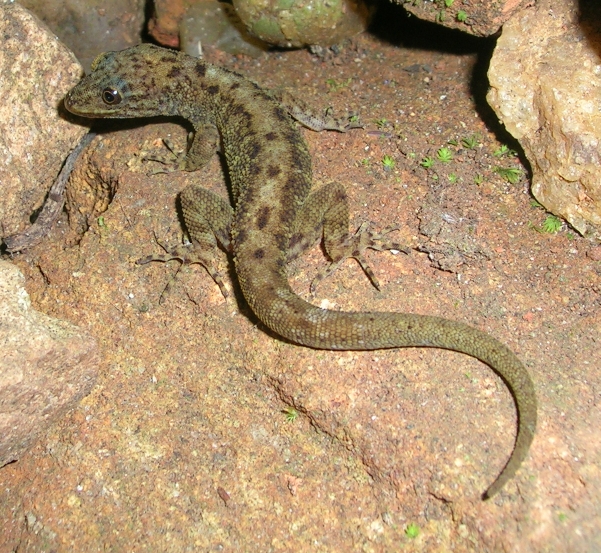|
Cnemaspis Tropidogaster
The rough-bellied day gecko (''Cnemaspis tropidogaster'') is a species of day geckos found in the Western Ghats of India and Sri Lanka. Its distribution in the southern Western Ghats is patchy and relatively uncommon. It is active during the day. It has a distinct head, elongated snout, and keeled ventral scales; Its dark-brown dorsal side has transverse arrangement of light and dark variegations. It is pale brown/cream on its underside with spiny tubercles on its sides. Males have two to four preanal and three to six femoral pores. Live populations were rediscovered nearly after 120 years from Sri Lanka in 2016 from a low elevation (50–80 m asl.) of the wet zone of Sri Lanka. Habitat and distribution A relatively uncommon day active gecko from the midhills of the Central Province Knuckles Mountain Range and also from Sabaragamuwa Province The Sabaragamuwa Province ( si, සබරගමුව පළාත ''Sabaragamuwa Paḷāta'', ta, சபரகமுவ மாக� ... [...More Info...] [...Related Items...] OR: [Wikipedia] [Google] [Baidu] |
George Albert Boulenger
George Albert Boulenger (19 October 1858 – 23 November 1937) was a Belgian-British zoologist who described and gave scientific names to over 2,000 new animal species, chiefly fish, reptiles, and amphibians. Boulenger was also an active botanist during the last 30 years of his life, especially in the study of roses. Life Boulenger was born in Brussels, Belgium, the only son of Gustave Boulenger, a Belgian public notary, and Juliette Piérart, from Valenciennes. He graduated in 1876 from the Free University of Brussels with a degree in natural sciences, and worked for a while at the Royal Belgian Institute of Natural Sciences, Brussels, as an assistant naturalist studying amphibians, reptiles, and fishes. He also made frequent visits during this time to the '' Muséum national d'Histoire naturelle'' in Paris and the British Museum in London. In 1880, he was invited to work at the Natural History Museum, then a department of the British Museum, by Dr. Albert C. L. G. Gün ... [...More Info...] [...Related Items...] OR: [Wikipedia] [Google] [Baidu] |
Cnemaspis
''Cnemaspis'' is a genus of diurnal (day) geckos found in Asia. With over 100 species, it is one of the most diverse genera of geckos. Molecular phylogenies suggest that the two regional groupings may form distinct clades which are not each other's closest relatives. Description Species in this genus have slender, clawed digits which are cylindrical or depressed at the base (rarely dilated); the distal phalanges are compressed, forming an angle with the basal portion of the digits, the lower surface of which has a row of plates. Their bodies are more or less depressed, granular or tubercular above. Tail not compressed. Pupil circular; eyelid distinct all round the eye. Males with or without pre-anal or femoral pores. Species The Indian Subcontinent and Sri Lanka group *'' C. aaronbaueri'' Sayyed, Grismer, Campbell & Dileepkumar, 2019 *'' C. adii'' C. Srinivasulu, Kumar & B. Srinivasulu, 2015 – Adi's day gecko *'' C. agarwali'' Khandekar, 2019 – Agarwal's dwarf ... [...More Info...] [...Related Items...] OR: [Wikipedia] [Google] [Baidu] |
Knuckles Mountain Range
The Knuckles Mountain Range lies in central Sri Lanka, in the Districts of Matale and Kandy. The range takes its name from a series of recumbent folds and peaks in the west of the massif which resemble the knuckles of clenched fist when viewed from certain locations in the Kandy District. Whilst this name was assigned by early British surveyors, the Sinhalese residents have traditionally referred to the area as ''Dumbara Kanduvetiya'' meaning Mist-laden Mountain Range. The higher montane area is often robed in thick layers of cloud. In addition to its aesthetic value, the range is of great scientific interest. It is a climatic microcosm of the rest of Sri Lanka as the conditions of all the climatic zones in the country are exhibited in the massif. At higher elevations there is a series of isolated cloud forests, harbouring a variety of flora and fauna. Although the range constitutes approximately 0.03% of the island's total area, it is home to a significantly higher proportion of ... [...More Info...] [...Related Items...] OR: [Wikipedia] [Google] [Baidu] |
Sabaragamuwa Province, Sri Lanka
The Sabaragamuwa Province ( si, සබරගමුව පළාත ''Sabaragamuwa Paḷāta'', ta, சபரகமுவ மாகாணம் ''Sabaragamuwa Mākāṇam'') is one of the nine provinces of Sri Lanka, the first level administrative division of the country. The provinces have existed since the 19th century but did not have any legal status until 1987 when the 13th Amendment to the Constitution of Sri Lanka established provincial councils. The Sabaragamuwa Province contains two districts: Ratnapura and Kegalle. It is named after its former indigenous inhabitants, namely the Sabara, an indic term for hunter-gatherer tribes, a term seldom used in ancient Sri Lanka. Sabaragamuwa University is in Belihuloya. Districts Sabaragamuwa is divided into 2 districts: * Kegalle District * Ratnapura District Municipal Council * Ratnapura Urban Council * Balangoda * Embilipitiya * Kegalle Other Towns * Bulathkohupitiya * Belihuloya * Eheliyagoda * Kalawana * Kuruw ... [...More Info...] [...Related Items...] OR: [Wikipedia] [Google] [Baidu] |
Eastern Province, Sri Lanka
The Eastern Province ( ta, கிழக்கு மாகாணம் ''Kiḻakku Mākāṇam''; si, නැගෙනහිර පළාත ''Næ̆gĕnahira Paḷāta'') is one of the nine provinces of Sri Lanka, the first level administrative division of the country. The provinces have existed since the 19th century but did not have any legal status until 1987 when the 13th Amendment to the Constitution of Sri Lanka established provincial councils. Between 1988 and 2006 the province was temporarily merged with the Northern Province to form the North Eastern Province. The capital of the province is Trincomalee. History In 1815 the British gained control of the entire island of Ceylon. They divided the island into three ethnic based administrative structures: Low Country Sinhalese, Kandyan Sinhalese and Tamil. The Eastern Province was part of the Tamil administration. In 1833, in accordance with the recommendations of the Colebrooke-Cameron Commission, the ethnic based ... [...More Info...] [...Related Items...] OR: [Wikipedia] [Google] [Baidu] |


_fort.jpg)